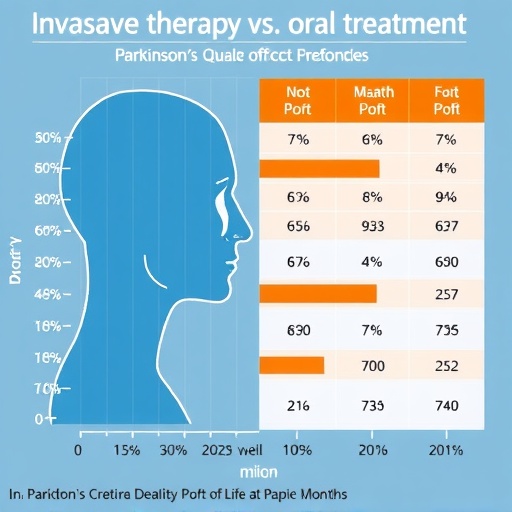In a groundbreaking longitudinal study published in 2025, researchers have shed new light on the quality of life in Parkinson’s disease patients undergoing different therapeutic regimens. The comparative analysis, spanning a full year, pits invasive device-aided therapies against the traditional oral treatments, unveiling nuanced insights that could revolutionize patient management and therapeutic decision-making in this debilitating neurodegenerative disorder.
Parkinson’s disease (PD), characterized primarily by motor symptoms such as tremor, bradykinesia, rigidity, and postural instability, has long posed a significant therapeutic challenge. Conventional oral treatments, mainly dopaminergic medications, have been the cornerstone of PD management for decades. However, their long-term efficacy is compromised by fluctuating plasma levels and the eventual emergence of motor complications like dyskinesia and “on-off” phenomena. This study’s focus on quality of life (QoL) metrics provides a crucial perspective beyond motor symptom control, reflecting the holistic impact of treatment modalities.
The research distinguishes itself by meticulously tracking QoL outcomes at twelve months post-intervention, evaluating two distinct cohorts: one receiving invasive device-aided therapies including deep brain stimulation (DBS) and continuous dopaminergic infusion systems, and the other cohort managed exclusively with optimized oral medication regimens. Such a comparative framework is rare, bridging a gap in longitudinal, patient-centered outcome reporting within the Parkinson’s therapeutic literature.
Device-aided therapies have gained traction as they target symptom control with continuous or stimulation-based modulation of neural circuits implicated in PD pathophysiology. Deep brain stimulation, for example, delivers high-frequency electrical pulses to specific basal ganglia structures, primarily the subthalamic nucleus or globus pallidus interna, aiming to restore dysfunctional motor pathways. Meanwhile, infusion therapies provide a steady dopaminergic supply, circumventing the erratic pharmacokinetics of oral agents. The study meticulously captures patients’ subjective and objective experiences with these diverse modalities, integrating standardized QoL assessment tools alongside clinical motor evaluations.
One striking finding is the significant improvement in global quality of life scores among the device-aided therapy group compared to the oral-only group after one year. These improvements transcend motor symptomatology alone, encompassing cognitive, emotional, and social functioning domains. The data underscore the multidimensional benefits of invasive treatments, suggesting their capacity to modulate disease impact beyond classical motor symptom relief, potentially through stabilization of neurotransmitter dynamics and reduction in medication-induced complications.
Moreover, the invasive treatment cohort demonstrated a marked decrease in motor fluctuations and dyskinesia severity, phenomena notoriously challenging to manage with oral therapies. The continuous dopaminergic delivery afforded by infusion systems, and the targeted circuit modulation through DBS, resulted in more predictable and consistent symptom control. This steadier state appears to translate into enhanced daily functioning and independence, key drivers of patient-perceived quality of life.
Nevertheless, the study does not overlook the inherent risks and challenges posed by invasive procedures. Device implantation carries surgical risks, including hemorrhage, infection, and hardware complications, necessitating a nuanced risk-benefit analysis. Importantly, the research highlights that patient selection criteria, timing of intervention, and multidisciplinary care profoundly influence outcomes. Tailoring intervention strategies to individual disease phenotypes and patient preferences emerged as a pivotal factor in maximizing QoL gains.
In contrast, the oral treatment cohort, while showing some stability in symptom management, reported comparatively stagnant or declining QoL metrics over the year. The pulsatile nature of oral therapy, coupled with dose escalation and side effects, appeared insufficient to prevent deterioration in several QoL dimensions. Cognitive and psychological burdens were notably higher, echoing the complex interplay between motor and non-motor symptoms intrinsic to PD progression.
The longitudinal design allowed for capturing fluctuations and trends often missed in cross-sectional analyses. By assessing QoL at multiple intervals culminating in the 12-month mark, the study provided a dynamic portrait of therapeutic impact, accommodating natural disease progression and treatment adaptation. Such temporal resolution is invaluable for clinicians crafting long-term care plans that prioritize patient-reported outcomes alongside clinical benchmarks.
Importantly, this research advances our understanding of how invasive therapies may modify the disease trajectory itself or at least mediate symptomatology in ways that preserve patients’ autonomy and well-being. The controlled neuromodulation and pharmacological delivery mechanisms inherent to these devices appear to recalibrate neural circuits beyond mere palliation. These mechanistic insights fuel a broader discussion about the role of interventional neurology in chronic neurodegenerative diseases.
The implications extend beyond clinical practice into healthcare policy and resource allocation. Devices are costly and necessitate specialized infrastructure, training, and post-implantation support. Yet, when evaluated against long-term medication costs, hospitalizations from motor complications, and diminished patient independence, device-aided therapies may prove economically favorable. This study equips stakeholders with critical data to revisit reimbursement paradigms and access frameworks for advanced PD therapies.
The neuroethical dimension also warrants attention. Patient autonomy in choosing invasive versus conservative treatment modalities hinges on comprehensive, transparent discussions surrounding expected outcomes, risks, and lifestyle impacts. The improved quality of life documented in the device-aided group could empower more patients and caregivers to consider these options earlier in their disease course, shifting the therapeutic paradigm.
Future research inspired by these findings might explore optimization of device parameters, integrative approaches combining pharmacotherapy and neuromodulation, and the refinement of biomarkers predicting treatment responsiveness. Additionally, the potential cognitive and neuropsychiatric effects of long-term device use merit deeper exploration given the complex neurobiology of Parkinson’s.
In conclusion, this landmark comparative study provides robust evidence supporting the superior quality of life outcomes associated with invasive device-aided therapies relative to oral treatments alone in Parkinson’s disease. By capturing the intricate, multidimensional benefits over a sustained period, it invites clinicians, patients, and policymakers to reconsider conventional therapeutic hierarchies. This advancement heralds a new era where technology-driven interventions can substantially alleviate the burden of one of the most challenging movement disorders of our time.
Subject of Research: Quality of life outcomes in Parkinson’s disease patients comparing invasive device-aided therapies with oral medication treatments over 12 months.
Article Title: Parkinson’s disease quality of life at 12 months comparing invasive device-aided therapy with oral treatment.
Article References:
Ramirez-Zamora, A., Okun, M.S., Kukreja, P. et al. Parkinson’s disease quality of life at 12 months comparing invasive device-aided therapy with oral treatment. npj Parkinsons Dis. 11, 235 (2025). https://doi.org/10.1038/s41531-025-01093-x
Image Credits: AI Generated




